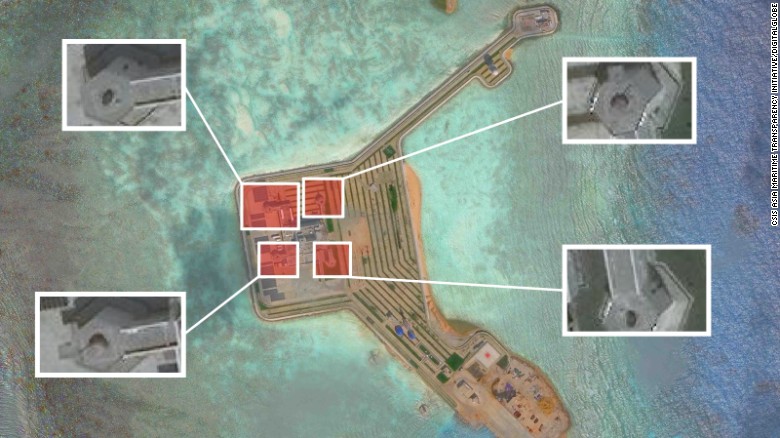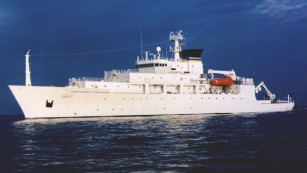Britain, France Join U.S. in Responding to Chinese Intimidation and Coercion in South China Sea
By Patrick Goodenough
Ships and submarines participating in the biennial RIMPAC exercise in 2012. The Obama administration invited China to take part in 2014 and 2016, but the Pentagon has rescinded the invitation for the 2018 exercises.
Britain and France are backing U.S.-led efforts to challenge what Defense Secretary James Mattis at the weekend called Chinese “intimidation and coercion” in the disputed South China Sea.
The two European defense ministers indicated in Singapore – where they and Mattis were taking part in the annual Shangri La security dialogue – that their navy ships will conduct “freedom of navigation” operations in the region in the coming days.
French armed forces minister Florence Parly said French and British ships would visit Singapore in the days ahead before “sailing together to certain areas.”
“I mean those areas where, at some point, a stern voice intrudes into the transponder, and tells us, sail away from supposedly territorial waters,” she continued.
“But our commander then calmly replies that he will sail forth, because these – under international law – are indeed international waters.”
British Defense Secretary Gavin Williamson, who spoke at the security event and addressed sailors onboard a Royal Navy frigate docked in Singapore, said Britain has sent three warships to the region, where their presence aims “to send the strongest of signals.”
“We believe that countries should play by the rules,” he said, stressing the importance of the “rules-based order.”
Like the U.S., France and Britain do not themselves have territorial claims in the resource-rich South China Sea, a vital thoroughfare for international trade.
As China has moved military assets to and around the islands, reefs and artificial islands it claims as Chinese, the U.S. has led the pushback.

China is engaged in disputes with the Philippines, Vietnam, Malaysia and Brunei over resource-rich areas of the South China Sea, an area that includes some of the world’s most important shipping trade corridors.
A recent U.S. “freedom of navigation” operation in the area saw two U.S. Navy warships sail within 12 nautical miles of islands claimed by China, Vietnam and Taiwan in the Paracel group.
British Defense Secretary Gavin Williamson, who spoke at the security event and addressed sailors onboard a Royal Navy frigate docked in Singapore, said Britain has sent three warships to the region, where their presence aims “to send the strongest of signals.”
“We believe that countries should play by the rules,” he said, stressing the importance of the “rules-based order.”
Like the U.S., France and Britain do not themselves have territorial claims in the resource-rich South China Sea, a vital thoroughfare for international trade.
As China has moved military assets to and around the islands, reefs and artificial islands it claims as Chinese, the U.S. has led the pushback.

China is engaged in disputes with the Philippines, Vietnam, Malaysia and Brunei over resource-rich areas of the South China Sea, an area that includes some of the world’s most important shipping trade corridors.
A recent U.S. “freedom of navigation” operation in the area saw two U.S. Navy warships sail within 12 nautical miles of islands claimed by China, Vietnam and Taiwan in the Paracel group.
Their presence drew sharp criticism from Beijing although Vietnam, which accuses China of illegally occupying the islands, welcomed the U.S. move.
In response to steps taken by China to back up its territorial claims by deploying military assets, the Pentagon has rescinded an invitation to China to participate in a major international military exercise in the Pacific this summer.
While China is excluded from the Rim of the Pacific (RIMPAC) exercises – after participating in the last two at the invitation of the Obama administration – Vietnam has been invited to take part for the first time since they began in 1971.
Other participants among the 26 nations include several further countries locked in territorial disputes with China in the South and East China Seas, including Japan, the Philippines, Malaysia and Brunei.
‘Much larger consequences’
Speaking at the security dialogue, which is hosted by the International Institute For Strategic Studies, Mattis had strong words for China.
He noted that Beijing has deployed anti-ship missiles, surface-to-air missiles, electronic jammers in the South China Sea and recently landed long-range bombers on an island in the Paracel group.
“Despite China’s claims to the contrary, the placement of these weapons systems is tied directly to military use for the purposes of intimidation and coercion,” Mattis said, adding that it also contravened assurances Xi Jinping gave to the U.S. during a visit to the White House in 2015.
During a question-and-answer session Mattis described the decision to disinvite China from “the world’s largest naval exercise” as a “relatively small consequence” of its behavior, but warned there could be “much larger consequences in the future” if it continues down its path.
In response to steps taken by China to back up its territorial claims by deploying military assets, the Pentagon has rescinded an invitation to China to participate in a major international military exercise in the Pacific this summer.
While China is excluded from the Rim of the Pacific (RIMPAC) exercises – after participating in the last two at the invitation of the Obama administration – Vietnam has been invited to take part for the first time since they began in 1971.
Other participants among the 26 nations include several further countries locked in territorial disputes with China in the South and East China Seas, including Japan, the Philippines, Malaysia and Brunei.
‘Much larger consequences’
Speaking at the security dialogue, which is hosted by the International Institute For Strategic Studies, Mattis had strong words for China.
He noted that Beijing has deployed anti-ship missiles, surface-to-air missiles, electronic jammers in the South China Sea and recently landed long-range bombers on an island in the Paracel group.
“Despite China’s claims to the contrary, the placement of these weapons systems is tied directly to military use for the purposes of intimidation and coercion,” Mattis said, adding that it also contravened assurances Xi Jinping gave to the U.S. during a visit to the White House in 2015.
During a question-and-answer session Mattis described the decision to disinvite China from “the world’s largest naval exercise” as a “relatively small consequence” of its behavior, but warned there could be “much larger consequences in the future” if it continues down its path.
He did not elaborate.
Militarizing features in the contested region, he said, is “not going to be endorsed in the world” and is not going to enhance China’s standing.
“There are consequences that will continue to come home to roost, so to speak, with China if they do not find the way to work more collaboratively with all of the nations who have interest” in the region.
Beijing’s defense ministry early this year invited Mattis to visit during the first half of the year, in what would be the first visit by a U.S. defense secretary in four years.
Militarizing features in the contested region, he said, is “not going to be endorsed in the world” and is not going to enhance China’s standing.
“There are consequences that will continue to come home to roost, so to speak, with China if they do not find the way to work more collaboratively with all of the nations who have interest” in the region.
Beijing’s defense ministry early this year invited Mattis to visit during the first half of the year, in what would be the first visit by a U.S. defense secretary in four years.
Speaking to reporters as he flew home from Singapore, Mattis said he still planned to go to China, despite the tensions over the South China Sea.








